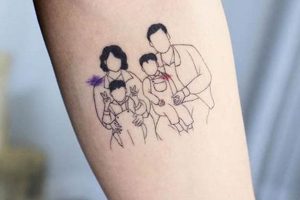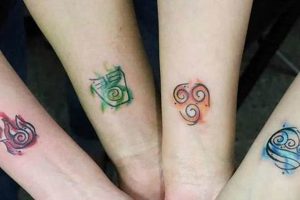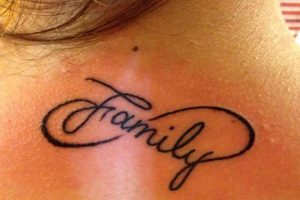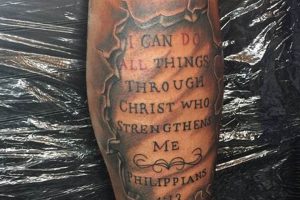Heraldic emblems, often representing lineage and heritage, are increasingly popular subjects for body art. These designs, drawn from historical symbols and familial traditions, offer a unique way to express personal identity and connection to one’s ancestry. Examples include incorporating elements like animals, mottos, shields, and other symbolic imagery into a custom tattoo design.
Representing a visual link to the past, these symbolic tattoos can foster a sense of belonging and pride in one’s family history. The historical significance of crests adds depth and meaning beyond mere aesthetics. Researching the symbolism within a specific emblem can reveal fascinating details about ancestral origins, values, and social standing. Such designs can serve as a powerful reminder of heritage and a celebration of familial bonds across generations.
This exploration will delve into design considerations, placement options, and the process of adapting historical imagery into a personalized, meaningful tattoo. It will also discuss the importance of thorough research and collaboration with skilled tattoo artists to ensure accurate representation and a visually compelling final result.
Tips for Heraldic Tattoo Designs
Careful consideration of several factors ensures a successful and meaningful heraldic tattoo. These tips offer guidance on design choices, research, and collaboration with tattoo artists.
Tip 1: Research Thoroughly: Genealogical research is crucial. Understanding the crest’s history and symbolism prevents inaccuracies and ensures an authentic representation of heritage.
Tip 2: Simplify for Clarity: Intricate details may not translate well to a tattoo. Simplifying the design while retaining key elements can improve visual impact and prevent blurring over time.
Tip 3: Consider Placement Carefully: The size and shape of the design should complement the chosen body part. Discuss placement options with a tattoo artist for optimal aesthetics and longevity.
Tip 4: Explore Artistic Styles: Traditional heraldic art is not the only option. Discuss potential artistic interpretations, such as watercolor, blackwork, or neo-traditional, with the tattoo artist to achieve a desired aesthetic.
Tip 5: Choose a Skilled Artist: Select a tattoo artist experienced in fine linework and detail-oriented designs. Review portfolios and consult with potential artists to ensure their style aligns with the desired outcome.
Tip 6: Incorporate Personal Touches: While maintaining historical accuracy, consider subtle personalizations, such as adding a meaningful date or incorporating other symbolic elements, to enhance the design’s significance.
Tip 7: Size Matters: A larger design allows for greater detail and complexity, while smaller designs require simplification. Balance desired size with placement and overall aesthetic.
By following these guidelines, individuals can create a lasting tribute to their heritage, ensuring a visually stunning and historically accurate representation of their family’s legacy. This process requires careful planning and open communication with a skilled artist.
These considerations pave the way for a final design that embodies both personal meaning and artistic excellence.
1. Genealogical Research
Genealogical research forms the crucial foundation for historically accurate and meaningful family crest tattoos. Understanding a crest’s true origin and associated symbolism prevents misrepresentation and imbues the tattoo with genuine personal significance. Without proper research, individuals risk adopting a crest that does not accurately reflect their lineage, diminishing the intended connection to heritage. For example, several families may share a common surname but have distinct crests. Research clarifies these distinctions, ensuring the chosen design aligns with the correct branch of the family tree.
Thorough research extends beyond simply identifying a crest associated with a surname. It delves into the history behind the specific symbols and elements within the crest, revealing stories of ancestral accomplishments, values, and geographic origins. This understanding transforms the tattoo from a decorative image into a powerful symbol of personal narrative. An individual might discover, for instance, that their crest features a lion, symbolizing courage and strength, a trait perhaps reflected in their own life or family history. This deeper understanding enhances the personal connection to the design.
The importance of genealogical research in this context cannot be overstated. It safeguards against historical inaccuracies and strengthens the bond between the individual and their heritage. While visually appealing designs can be created without research, the true power of a family crest tattoo lies in its accurate and meaningful representation of lineage. This meticulous approach elevates the tattoo to a more profound and enduring symbol of familial identity.
2. Design Simplification
Design simplification plays a vital role in adapting intricate heraldic crests into successful tattoo designs. While crests often feature fine details and complex imagery, direct translation onto skin can lead to visual clutter or loss of clarity over time. Simplification retains the core essence of the crest while optimizing it for the tattoo medium. This process requires careful consideration of which elements are essential for maintaining historical accuracy and visual impact.
- Prioritizing Key Elements:
Simplification involves identifying the most prominent and symbolic elements within the crest. These core components, such as the primary charge, shield shape, and dominant colors, convey the crest’s essence even in a simplified form. For instance, a complex crest featuring numerous small figures might be simplified by focusing on a single, larger representation of the central figure, retaining the symbolic meaning while improving visual clarity.
- Linework and Detail Reduction:
Intricate linework, common in traditional crests, may not translate well to a tattoo. Simplifying the linework reduces visual clutter and prevents the design from blurring as the tattoo ages. This might involve omitting fine details or combining multiple elements into a single, bolder representation. For example, fine patterns within a crest could be represented by a simpler, more defined texture.
- Color Palette Adaptation:
Crests often employ a wide range of colors. For tattoos, simplifying the color palette can improve visual impact and longevity. Limiting the number of colors and focusing on bolder shades prevents the tattoo from appearing muddied over time. This might involve substituting subtle color gradations with solid blocks of color or using a monochromatic palette for a more striking effect.
- Balancing Detail and Scale:
The desired size of the tattoo significantly influences the level of simplification required. Smaller tattoos necessitate greater simplification to ensure clarity, while larger designs allow for more detailed representation. This balance requires careful planning and collaboration with the tattoo artist to achieve the desired visual impact without compromising the integrity of the crest. A small wrist tattoo, for example, might feature only the central charge of the crest, while a larger back piece could incorporate more elements.
Effective simplification enhances the visual impact and longevity of family crest tattoos. By prioritizing key elements, streamlining linework, adapting the color palette, and considering scale, individuals can ensure their chosen crest translates effectively into a striking and enduring piece of body art. This careful approach honors the historical significance of the crest while maximizing its aesthetic potential in the tattoo medium.
3. Strategic Placement
Strategic placement significantly impacts the overall aesthetic and symbolic meaning of family crest tattoos. Consideration of body contours, visibility preferences, and the design’s size and shape ensures the tattoo complements the individual’s physique and effectively conveys the intended message. Thoughtful placement enhances both the visual appeal and personal significance of the design.
- Body Contours and Flow:
The natural curves and lines of the body influence how a tattoo appears. Placement should complement these contours, allowing the design to flow harmoniously with the body’s shape. A crest with a predominantly vertical orientation, for example, might be well-suited for placement along the forearm or spine, while a wider, horizontal design might be better placed across the chest or back. This consideration ensures the tattoo integrates seamlessly with the individual’s physique, enhancing its visual appeal.
- Visibility and Discretion:
Placement determines how visible the tattoo will be. Individuals may prefer a prominent display or a more discreet location, depending on personal preference and social context. Common placements for prominent displays include the forearm, upper arm, and back. More discreet locations include the back of the neck, ribs, or ankle. This choice reflects the individual’s desire to share their heritage openly or to reserve its display for more personal moments.
- Size and Shape Considerations:
The size and shape of the crest design dictate appropriate placement. Larger, more detailed designs require ample space, such as the back, chest, or thigh. Smaller, simpler designs can be placed on areas like the wrist, ankle, or behind the ear. This consideration ensures the design fits comfortably within the chosen area, avoiding a cramped or distorted appearance.
- Symbolic Significance of Location:
Placement can further enhance the symbolic meaning of the tattoo. Positioning the crest over the heart, for example, might emphasize the importance of family and heritage to the individual. Placement on the dominant arm could symbolize strength and the active upholding of family traditions. Such choices add another layer of personal meaning to the design, transforming it into a more profound statement of identity.
Strategic placement elevates family crest tattoos beyond mere decoration, transforming them into well-integrated and meaningful expressions of personal heritage. By considering body contours, visibility preferences, size and shape, and symbolic significance, individuals can ensure their chosen design complements their physique and effectively conveys the profound connection to their ancestry.
4. Artistic Style Choices
Artistic style significantly influences the final aesthetic and overall impact of family crest tattoos. Selecting an appropriate style bridges the gap between traditional heraldic imagery and contemporary tattoo aesthetics, allowing for personalized interpretations that resonate with individual preferences. This choice impacts not only the visual appeal but also the perceived meaning and emotional resonance of the design. A crest rendered in a bold, traditional style, for example, might evoke a sense of strength and history, while a watercolor interpretation could suggest a more fluid and contemporary connection to heritage.
Various artistic styles offer unique possibilities for representing family crests in tattoo form. Traditional styles, with their bold lines and vibrant colors, emphasize the historical aspect of the crest, creating a classic and timeless aesthetic. Realistic styles focus on intricate detail and shading, replicating the crest’s appearance with precision. Watercolor styles, characterized by soft washes and vibrant hues, offer a more contemporary and artistic interpretation. Blackwork styles, using only black ink, create a striking and dramatic effect, often emphasizing the crest’s symbolic elements through negative space. Geometric styles incorporate geometric patterns and shapes, adding a modern and abstract twist to the traditional design. The choice of style reflects individual preferences and can enhance the symbolic meaning of the crest. For instance, a family known for its artistic inclinations might choose a watercolor style, while a family with a military history might prefer a traditional or realistic representation.
Careful consideration of artistic style ensures the family crest tattoo effectively communicates the intended message and resonates with personal aesthetics. Collaboration with a skilled tattoo artist experienced in the chosen style is crucial for achieving a successful outcome. Understanding the nuances of each style and their potential impact on the final design empowers individuals to make informed choices that align with their vision and honor their family heritage. Selecting the right style is an essential step in transforming a historical emblem into a powerful and personalized piece of body art.
5. Skilled Artist Selection
Realizing the full potential of family crest tattoo ideas hinges on selecting a skilled tattoo artist. A thoughtfully chosen artist possesses the technical expertise and artistic sensibility to translate intricate heraldic designs into compelling body art. This choice directly impacts the tattoo’s quality, accuracy, and longevity, transforming a symbolic concept into a lasting piece of personal heritage.
- Technical Proficiency:
Technical proficiency encompasses precision linework, shading, and color blending techniques. A skilled artist demonstrates mastery in these areas, ensuring clean lines, smooth shading transitions, and vibrant, long-lasting color saturation. This expertise is crucial for rendering the intricate details often found in heraldic crests. An artist’s portfolio should showcase examples of fine linework and complex designs, indicating their ability to handle the specific challenges of crest tattoos. For instance, an artist proficient in fine linework can accurately reproduce the delicate details of a crest’s mantling, while a skilled color artist can capture the vibrancy of heraldic tinctures.
- Style Alignment:
Different tattoo artists specialize in various artistic styles, such as traditional, realism, watercolor, or blackwork. Selecting an artist whose style aligns with the desired aesthetic ensures the final result resonates with individual preferences. Researching an artist’s portfolio allows potential clients to assess their stylistic strengths and determine whether their approach complements the desired interpretation of the family crest. A crest rendered in a traditional style, for example, might emphasize bold lines and bright colors, while a watercolor approach could offer a softer, more artistic interpretation. Aligning artistic style with personal preference ensures the tattoo’s aesthetic reflects the individual’s connection to their heritage.
- Experience with Heraldic Imagery:
Prior experience with heraldic imagery equips an artist with the understanding of its specific design principles and symbolism. This familiarity ensures accurate representation and avoids misinterpretations of the crest’s elements. An experienced artist can guide clients through design choices that maintain historical accuracy while adapting the crest for the tattoo medium. This experience also extends to understanding the specific challenges of translating intricate designs onto curved surfaces, ensuring the crest’s integrity is maintained regardless of placement. For instance, an artist familiar with heraldry understands the significance of tinctures and can advise on color choices that adhere to traditional heraldic conventions.
- Consultation and Collaboration:
Open communication and a collaborative approach are essential for a successful outcome. A skilled artist engages in thorough consultations, actively listening to client preferences and offering expert guidance. This collaborative process fosters a shared understanding of the design goals, ensuring the final tattoo reflects both the individual’s vision and the artist’s expertise. A collaborative artist encourages clients to ask questions, share their family history, and express their desired aesthetic, fostering a sense of trust and ensuring the final design holds genuine personal meaning. This collaborative approach transforms the tattooing process into a shared artistic endeavor, resulting in a more meaningful and personalized piece of art.
Skilled artist selection is paramount in transforming family crest tattoo ideas into enduring representations of heritage. By prioritizing technical proficiency, style alignment, experience with heraldic imagery, and a collaborative approach, individuals ensure their chosen crest is rendered with accuracy, artistry, and lasting impact. This careful selection process elevates the tattoo beyond mere decoration, transforming it into a powerful symbol of familial pride and historical connection.
6. Personalization Options
Personalization options transform family crest tattoos from generic representations of lineage into unique expressions of individual identity. These options allow for subtle yet meaningful modifications that enhance the crest’s personal significance, creating a design that resonates deeply with the wearer’s own story and values. While respecting the historical integrity of the crest remains important, personalization imbues the design with contemporary relevance and strengthens the connection between individual and heritage.
- Incorporation of Mottoes or Quotes:
Family mottoes, often inscribed on traditional crests, provide a powerful avenue for personalization. Incorporating the motto into the tattoo design adds a textual element that reinforces the family’s values and guiding principles. Alternatively, a personally meaningful quote, perhaps one that resonates with the individual’s own philosophy or life experiences, can further enhance the tattoo’s significance. For example, a family motto of “Strength and Honor” can be incorporated alongside the crest, or a personally chosen quote reflecting resilience or determination can further personalize the design. This textual addition deepens the tattoo’s narrative and strengthens its connection to personal values.
- Integration of Significant Dates:
Adding significant dates, such as birth years, anniversaries, or dates commemorating important family events, anchors the crest within a personal timeline. This integration connects the historical symbolism of the crest with the individual’s own life journey, creating a tangible link between past and present. For example, incorporating a grandparent’s birth year subtly weaves their memory into the design, creating a lasting tribute. These chronological markers add depth and personal resonance, transforming the crest into a visual representation of familial continuity.
- Addition of Symbolic Elements:
Subtle additions of symbolic elements further personalize the crest’s meaning. These additions might include birth flowers, astrological symbols, or elements representing personal hobbies or passions. Such additions weave elements of individual identity into the historical narrative of the crest, creating a richer and more multifaceted symbol. For instance, a musician might incorporate a musical note or instrument into the design, or someone passionate about nature might add a symbolic representation of their favorite flower or animal. These additions personalize the crest without compromising its historical integrity, creating a design that speaks to both lineage and individual identity.
- Adaptation of Artistic Style:
Artistic style serves as a powerful tool for personalization. While respecting the core elements of the crest, adapting its visual representation through different artistic styles allows for individual expression. A crest rendered in a bold, traditional style might convey a sense of strength and history, while a watercolor interpretation suggests a more fluid and contemporary connection to heritage. Choosing a style that resonates with personal aesthetics enhances the tattoo’s overall impact and reinforces its connection to individual identity. For example, an individual with a minimalist aesthetic might prefer a simplified, geometric interpretation of their crest, while someone drawn to vibrant colors might choose a watercolor rendering. This stylistic choice transforms the crest into a personalized artistic expression.
Personalization options empower individuals to imbue family crest tattoos with unique meaning, transforming them from traditional emblems into powerful expressions of personal identity. By thoughtfully incorporating mottoes, dates, symbolic elements, and artistic style choices, individuals create a design that honors their heritage while simultaneously reflecting their own values, experiences, and aesthetic preferences. This personalized approach strengthens the bond between individual and ancestry, transforming the tattoo into a deeply meaningful and enduring symbol of familial connection.
7. Appropriate Sizing
Appropriate sizing is paramount for successful family crest tattoo designs. Size directly impacts legibility, detail retention, and overall aesthetic harmony. A crest too small may lose intricate details, rendering its symbolism unclear. Conversely, an overly large design may appear disproportionate or overwhelm the chosen placement area. Consider a crest intended for the inner wrist. Miniaturizing a complex design to fit this area risks losing crucial details, while enlarging it could compromise both aesthetics and practicality. Balancing size with placement and design complexity ensures the crest’s visual integrity and symbolic meaning remain clear.
Determining appropriate size necessitates careful consideration of several factors. Design complexity influences minimum size requirements; intricate crests require more space than simpler designs. Placement area limitations restrict maximum size. A crest intended for the back allows for greater size and detail than one designed for a finger. Furthermore, individual preferences play a role. Some individuals prefer smaller, more discreet tattoos, while others desire larger, more prominent displays. For example, a detailed crest might be appropriately sized for a large back piece but require simplification for a smaller placement on the forearm. Understanding these factors enables informed decisions that balance design integrity with individual preferences and anatomical limitations.
Appropriate sizing ensures the family crest tattoo remains visually clear, symbolically accurate, and aesthetically pleasing over time. Careful consideration of design complexity, placement limitations, and individual preferences allows for informed decisions regarding scale. This thoughtful approach prevents loss of detail, maintains balanced proportions, and ultimately enhances the tattoo’s ability to serve as a meaningful and enduring representation of family heritage.
Frequently Asked Questions
This section addresses common inquiries regarding family crest tattoo designs, offering clarity and guidance for those considering such a tattoo.
Question 1: How does one determine the authenticity of a family crest?
Thorough genealogical research is crucial. Reputable heraldic resources, such as historical societies and genealogical libraries, offer guidance and documentation. Consulting with professional genealogists can also provide expert verification.
Question 2: Can a family crest be modified for a tattoo design?
While maintaining historical accuracy is essential, stylistic adaptations and subtle personalizations are acceptable. However, significant alterations that compromise the crest’s core elements are generally discouraged. Consulting with experienced heraldic artists or tattoo artists specializing in crest designs ensures appropriate modifications.
Question 3: What factors influence the cost of a family crest tattoo?
Size, complexity, artistic style, artist experience, and geographic location all influence pricing. Detailed, larger designs require more time and skill, thus increasing cost. Highly experienced artists often command higher rates. Obtaining quotes from multiple artists is recommended.
Question 4: How does one choose appropriate placement for a family crest tattoo?
Placement depends on design size, individual preference, and visibility considerations. Larger designs suit areas like the back or chest. Smaller, simpler crests can be placed on the wrist, forearm, or ankle. Placement should complement body contours and align with personal visibility preferences. Consulting with a tattoo artist provides valuable insights regarding placement options.
Question 5: What steps ensure a family crest tattoo ages well?
Choosing a skilled artist specializing in fine linework and employing high-quality inks is critical for longevity. Proper aftercare, including sun protection and moisturizing, significantly impacts the tattoo’s appearance over time. Regular touch-ups might be necessary to maintain vibrancy.
Question 6: What if an individual cannot find a documented family crest?
Individuals without a documented family crest can explore alternative options that represent their heritage. These might include symbolic representations of ancestral homelands, meaningful family mottos, or portraits of significant ancestors. Collaborating with a skilled tattoo artist to develop a custom design allows for creative expressions of heritage even without a traditional crest.
Careful research, thoughtful design choices, and collaboration with experienced professionals are essential for creating a meaningful and enduring family crest tattoo.
This information serves as a starting point for exploring the rich possibilities of family crest tattoo designs. Further research and consultation with experts are encouraged to ensure a personalized and historically informed final product.
Family Crest Tattoo Ideas
Exploration of heraldic tattoo designs reveals the potential for powerful expressions of heritage and personal identity. Careful consideration of genealogical research, design simplification, strategic placement, artistic style, artist selection, personalization options, and appropriate sizing ensures a meaningful and enduring result. These elements combine to transform historical emblems into personalized works of art, reflecting both ancestral connections and individual narratives.
Family crest tattoos offer a tangible link to the past, carrying stories and symbolism across generations. Embarking on this journey requires thoughtful consideration and thorough research. Collaboration with skilled artists and careful attention to detail result in a lasting tribute to family history, etched not only onto skin but also into personal narratives.







